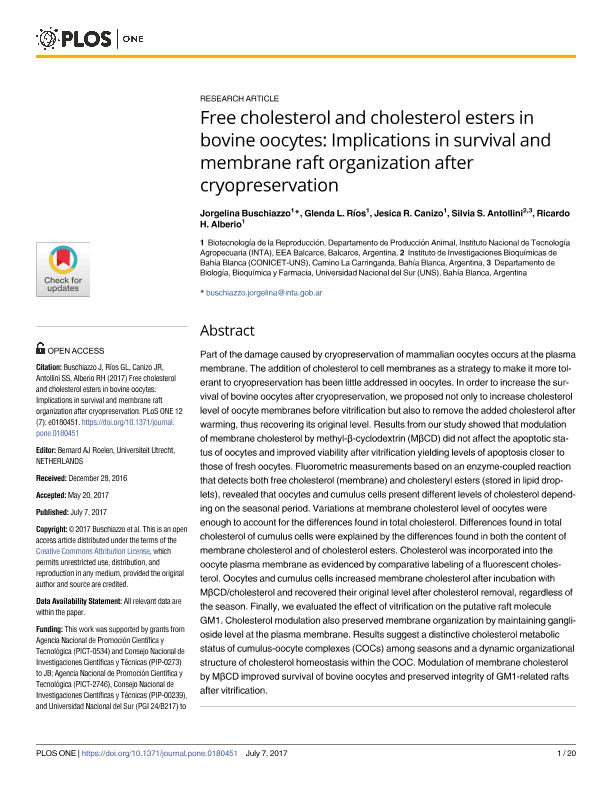Artículo
Free cholesterol and cholesterol esters in bovine oocytes: Implications in survival and membrane raft organization after cryopreservation
Buschiazzo, Jorgelina ; Ríos, Glenda L.; Canizo, Jesica R.; Antollini, Silvia Susana
; Ríos, Glenda L.; Canizo, Jesica R.; Antollini, Silvia Susana ; Alberio, Ricardo H.
; Alberio, Ricardo H.
 ; Ríos, Glenda L.; Canizo, Jesica R.; Antollini, Silvia Susana
; Ríos, Glenda L.; Canizo, Jesica R.; Antollini, Silvia Susana ; Alberio, Ricardo H.
; Alberio, Ricardo H.
Fecha de publicación:
07/07/2017
Editorial:
Public Library of Science
Revista:
Plos One
ISSN:
1932-6203
Idioma:
Inglés
Tipo de recurso:
Artículo publicado
Clasificación temática:
Resumen
Part of the damage caused by cryopreservation of mammalian oocytes occurs at the plasma membrane. The addition of cholesterol to cell membranes as a strategy to make it more tolerant to cryopreservation has been little addressed in oocytes. In order to increase the survival of bovine oocytes after cryopreservation, we proposed not only to increase cholesterol level of oocyte membranes before vitrification but also to remove the added cholesterol after warming, thus recovering its original level. Results from our study showed that modulation of membrane cholesterol by methyl-β-cyclodextrin (MβCD) did not affect the apoptotic status of oocytes and improved viability after vitrification yielding levels of apoptosis closer to those of fresh oocytes. Fluorometric measurements based on an enzyme-coupled reaction that detects both free cholesterol (membrane) and cholesteryl esters (stored in lipid droplets), revealed that oocytes and cumulus cells present different levels of cholesterol depending on the seasonal period. Variations at membrane cholesterol level of oocytes were enough to account for the differences found in total cholesterol. Differences found in total cholesterol of cumulus cells were explained by the differences found in both the content of membrane cholesterol and of cholesterol esters. Cholesterol was incorporated into the oocyte plasma membrane as evidenced by comparative labeling of a fluorescent cholesterol. Oocytes and cumulus cells increased membrane cholesterol after incubation with MβCD/cholesterol and recovered their original level after cholesterol removal, regardless of the season. Finally, we evaluated the effect of vitrification on the putative raft molecule GM1. Cholesterol modulation also preserved membrane organization by maintaining ganglioside level at the plasma membrane. Results suggest a distinctive cholesterol metabolic status of cumulus-oocyte complexes (COCs) among seasons and a dynamic organizational structure of cholesterol homeostasis within the COC. Modulation of membrane cholesterol by MβCD improved survival of bovine oocytes and preserved integrity of GM1-related rafts after vitrification.
Archivos asociados
Licencia
Identificadores
Colecciones
Articulos(CCT - MAR DEL PLATA)
Articulos de CTRO.CIENTIFICO TECNOL.CONICET - MAR DEL PLATA
Articulos de CTRO.CIENTIFICO TECNOL.CONICET - MAR DEL PLATA
Articulos(INIBIBB)
Articulos de INST.DE INVEST.BIOQUIMICAS BAHIA BLANCA (I)
Articulos de INST.DE INVEST.BIOQUIMICAS BAHIA BLANCA (I)
Citación
Buschiazzo, Jorgelina; Ríos, Glenda L.; Canizo, Jesica R.; Antollini, Silvia Susana; Alberio, Ricardo H.; Free cholesterol and cholesterol esters in bovine oocytes: Implications in survival and membrane raft organization after cryopreservation; Public Library of Science; Plos One; 12; 7; 7-7-2017; 1-20
Compartir
Altmétricas



